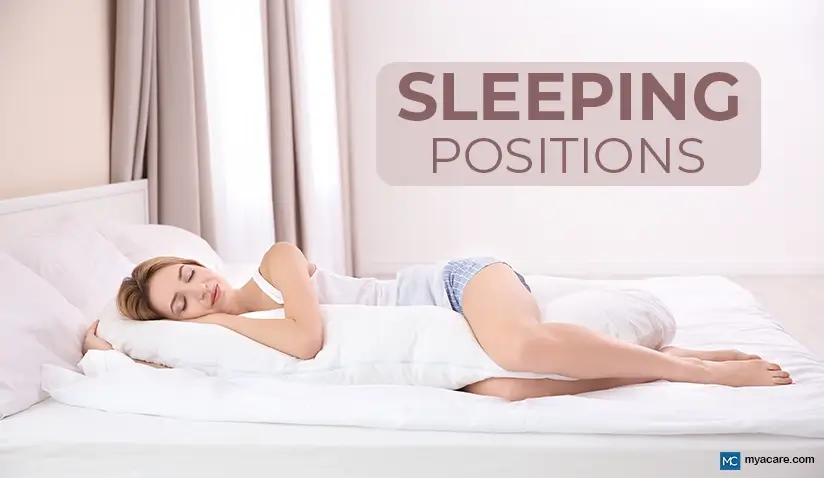Sleeping Positions: The Pros and Cons of Back and Side Sleeping

Medically Reviewed by Dr. Rae Osborn, Ph.D. - August 2, 2024
The Importance of Sleep Positions
Sleep Position Recommendations for Health Conditions
Getting a good night’s rest is imperative for overall well-being. A pressing factor that can affect the quality of our sleep is our sleeping position.
The position one sleeps in is essential because it impacts spinal alignment, posture, blood circulation, pressure distribution, and breathing patterns. These factors can determine sleep quality and how effectively sleep can perform its primary functions.
Sleep is essential to our well-being, so the wrong position could be detrimental to our health. Poor sleeping posture can lead to sleep disturbance, discomfort, morning stiffness, and snoring.
Snoring is often a sign of sleep apnea, a condition in which breathing is disrupted at night, causing the person to awaken frequently. Obstructive sleep apnea can lead to daytime somnolence and high blood pressure, as well as a higher risk of diabetes, obesity, and premature aging. Snoring is one example of how our sleeping position can influence our health and risk for disease, since it can increase our risk of heart problems and strokes.
While some prefer sleeping on their side, others find comfort in sleeping on their back. Which side is the best?
This blog aims to weigh the pros and cons of sleeping on your side or back and the health benefits of each position.
The Importance of Sleep Positions
Our sleep position is vital for maintaining proper spinal alignment and overall health. A good sleep position can also help alleviate common sleep issues such as snoring, lower back pain, and knee pain.
There is no best sleeping position. Each position has advantages and disadvantages, as reviewed below.
Side Sleeping: Pros and Cons
Side sleeping is the most common sleep position, with approximately 60% of people preferring to sleep on their side.[1]
- Lower morning stiffness and pain[2]
- Improved digestion and heartburn relief (left side sleeping)
- Less pressure on the heart (right side sleeping)
- Reduced sleep apnea symptoms
- Promotes the fastest waste removal from the brain during sleep of all sleeping positions
- Improved blood circulation and reduced pressure on the back (especially for pregnant women)
Side sleeping also has its drawbacks.
Sleeping on your side can place pressure on your shoulder, leading to shoulder pain. If you do not sleep with your neck up on the pillow, it may cause neck pain.
Side sleeping can lead to more acne or wrinkles on your face due to the constant friction on one side of your face. Side sleeping can also cause hip pain if your mattress does not provide enough support.
Back Sleeping: Pros and Cons
Back sleeping, also known as supine sleeping, is the second most popular sleep position, with approximately 16% of people preferring to sleep on their back.[3]
Here are some of the known benefits of back sleeping:
- Recommended for maintaining proper spinal alignment
- Reduces pressure on the neck and shoulders
- Possibly decreases lower back pain
- It might lessen the appearance of wrinkles and acne and is the best position for healthy skin
- Best position for optimal breathing (but not for snoring)
- It is more straightforward to sleep at an elevated angle to prevent fluids from pooling in the lungs
Back sleeping can worsen existing conditions such as sleep apnea. A study found that more than half of people with sleep apnea snore because they sleep on their backs and that this aggravates their symptoms.
If fluid buildup in the lungs causes sleep apnea, then back sleeping may help to lessen it as it is easier to sleep at a 45-degree angle on the back.
Supine sleeping can also cause lower back pain if your mattress lacks support.
Pregnant women should avoid supine sleeping, especially in the third trimester. Studies found it can place pressure on the veins and arteries, supplying sustenance to the womb. It may also increase the risk of maternal hypotension and stillbirth.
Sleeping on Your Stomach
Prone sleeping or sleeping on your tummy is the least recommended sleep position, as it can cause several health issues. In the long term, stomach sleeping can put pressure on your spinal column and cause neck pain, back pain, and hip pain.
Some people find comfort in this position. The advantages of sleeping on your stomach include reduced snoring.
Sleep Position Recommendations for Health Conditions
While it is clear that our sleeping posture is significant for health, there is no conclusive evidence on the best position.
Limited evidence suggests the following sleeping position recommendations for health conditions:
Sleep Apnea: Experts recommend side sleeping for individuals with sleep apnea. Sleeping on the back might exacerbate the symptoms of sleep apnea and raise the risk of airway blockages.
Pregnancy: For pregnant women, sleeping on the side, particularly the left side, is often recommended. This position facilitates blood flow to the developing fetus and helps prevent the uterus from pressing on the liver, reducing the risk of complications.
Hip Joint Pain: Sleep on your back with a pillow under your knees for the best results. If you prefer to sleep on your side, try placing a cushion between your legs for hip support.
GERD (Gastroesophageal Reflux Disease), Heartburn, and Indigestion: For individuals with GERD, heartburn, and indigestion, sleeping on the left side is often recommended. This position can help prevent stomach acid from flowing back into the esophagus, reducing symptoms.
Heart Disease: Some studies suggest sleeping on the right side may be beneficial for people with heart disease.
Heart Failure: For individuals with congestive heart failure, sleeping in an elevated position is generally advisable. Falling asleep on a wedge pillow or elevating the head of the bed can take pressure off the heart. Sleeping in an elevated position also helps to reduce fluid retention and ease breathing.
Fibromyalgia: For individuals with fibromyalgia, sleeping in a side position can help alleviate musculoskeletal pain and promote better sleep quality.
Tennis Elbow: Sleeping with the arms raised over the head is not a good idea for those with tennis elbow. One study reveals that those with elbow joint issues can increase symptom severity and delay healing if they sleep this way. Sleep with your arms down if you have tennis elbow.
Which Side to Sleep on with a Ruptured Eardrum?
If you have a ruptured eardrum, sleeping on the unaffected side is considered best.[4] Sleeping on the unaffected side can help prevent additional pressure or irritation on the ruptured eardrum, allowing it to heal properly. It can also help ear drops to get fully absorbed.
If both eardrums are ruptured, it is advisable to sleep on the back to avoid placing pressure on either ear.
Speaking with a healthcare practitioner for tailored advice and guidance regarding your condition is always best.
Best Practices for Side and Back Sleeping
Now that we have outlined the benefits and drawbacks of side and back sleeping let us look at some best practices for each position.[5]
Side Sleeping
If you prefer sleeping on your side, here are some tips to ensure you get the most out of this position:
- Alternate sides: Sleeping on the identical side each night can lead to muscle imbalances and discomfort. It is essential to alternate sides to maintain proper spinal alignment and to avoid pressure always being placed on one side of the body.
- Use a leg pillow: Placing a pillow between your knees can help alleviate hip pain, promote body symmetry, and maintain proper spinal alignment. Studies link side sleeping with a leg pillow to less morning stiffness and symptoms.
- Try the fetal position: Sleeping in the fetal position, with the knees folded towards the chest, can help alleviate lower back pain and reduce snoring.
- Avoid touching your forehead: One study reveals that side sleeping with your pillow tucked under your arm and your hand on your head can increase shoulder and neck pain.
Should I Sleep on the Left or Right Side?
Side sleeping comes with two options: left or right. The side you choose to sleep on has little overall impact on sleep quality and well-being, especially as side sleepers often alternate.
However, sleeping on one side has advantages over the other for specific conditions. One study found that sleeping on the right side could be the best option for people without digestive issues, regardless of whether they have a heart condition. People who sleep on the right side wake up in less pain more often than those who sleep on the left side. Taking pressure off the heart may enhance blood flow and reduce the chances of morning stiffness.
Back Sleeping
If you prefer sleeping on your back, here are some tips to ensure you get the most out of this position:
- Use a pillow under your knees: Placing a cushion under your knees can help soothe lower back pain and maintain proper spinal alignment.
- Avoid snoozing on your stomach: Sleeping on your belly can put pressure on your spine, leading to neck and shoulder pain.
Conclusion
In conclusion, both side and back sleeping have their own set of pros and cons. Let us briefly review the key takeaways from the blog:
- Side sleeping is the most common sleep position, with several health benefits, such as improved digestion and reduced heartburn. However, it can also cause shoulder pain and wrinkles.
- Back sleeping is recommended for maintaining proper spinal alignment and breathing at an angle. It can, however, cause snoring and worsen existing conditions such as sleep apnea.
- Proper spinal alignment is essential, and a supportive mattress ensures a good night's sleep.
- Other sleeping positions, such as sleeping on your stomach, can cause several health issues and are not recommended.
Ultimately, your best sleep position depends on your preferences and health conditions. Your personal sleep haven should be a place of comfort and relaxation, regardless of your preferred sleep position.
To search for some of the best Ear, Nose Throat (ENT) worldwide, please the Mya Care search engine
To search for the best doctors and healthcare providers worldwide, please use the Mya Care search engine.
The Mya Care Editorial Team comprises medical doctors and qualified professionals with a background in healthcare, dedicated to delivering trustworthy, evidence-based health content.
Our team draws on authoritative sources, including systematic reviews published in top-tier medical journals, the latest academic and professional books by renowned experts, and official guidelines from authoritative global health organizations. This rigorous process ensures every article reflects current medical standards and is regularly updated to include the latest healthcare insights.

Dr. Rae Osborn has a Ph.D. in Biology from the University of Texas at Arlington. She was a tenured Associate Professor of Biology at Northwestern State University, where she taught many courses to Pre-nursing and Pre-medical students. She has written extensively on medical conditions and healthy lifestyle topics, including nutrition. She is from South Africa but lived and taught in the United States for 18 years.
Sources:
Featured Blogs



